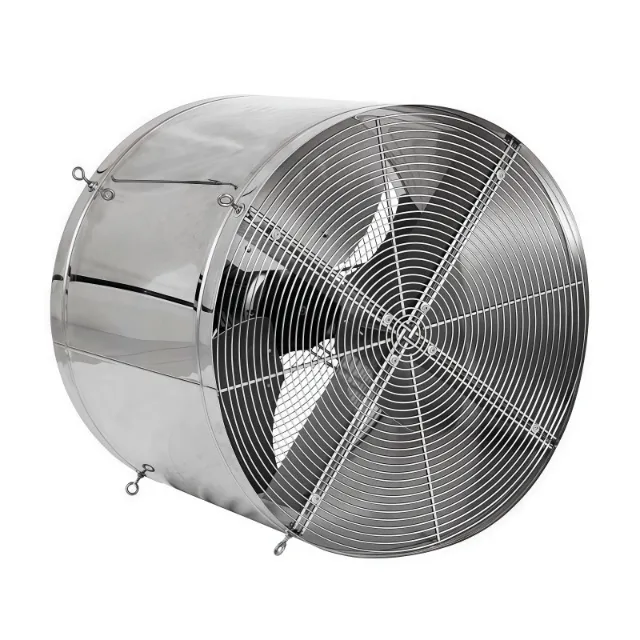Greenhouse Fan in the United States: Tips from a Specialist

Introduction
Greenhouses across the United States come in many shapes and sizes, just like the plants grown inside them. From tomato farms in California to flower nurseries in Florida, every grower faces a similar problem. Heat and moisture build up fast if the air is not moving. When this happens, plants get weak, diseases spread, and harvests drop. That is why fans and cooling systems are not only useful but truly necessary for greenhouse work.
In this article, we talk about how fans are used in U.S. greenhouses, what details farmers often focus on, and how new tools have changed the way air is managed.
Choosing the Right Greenhouse Fan
Key Factors to Consider
The first thing to look at is the greenhouse size. A small family greenhouse in Ohio needs less airflow than a huge commercial house in Arizona. Climate matters too. In the wet and warm Southeast, too much water in the air is the main challenge. In the hot and dry Southwest, the focus is on lowering temperature. Energy price is also important, since U.S. growers pay high monthly bills. That is why the fan must be strong but also use less electricity.
Types of Greenhouse Fans Available
Industrial Exhaust Fans
Exhaust fans are the heavy duty choice in many large greenhouses. They push out hot and damp air and let cooler air come inside. For example, citrus greenhouses in Texas often use big roof exhaust fans to fight against strong summer heat. A few degrees cooler can save crops. Exhaust fan models with fiberglass shells are common because they do not rust easily, even when exposed to high humidity and fertilizers.
Circulation Fans
Even when exhaust fans are in place, some corners can stay warm and still. Circulation fans help by keeping air moving inside. This avoids hot zones and spreads fresh air more evenly. In Colorado, lettuce farms often use hanging circulation fans to keep the leaves fresh and healthy. Airflow also lowers the chance of fungus. Circulation fans are built for farm use, so they can run for long hours and are easy to clean.
Cooling Pad
In very hot places like Nevada or Arizona, fans alone are not enough. Cooling pads work together with exhaust fans to drop the temperature. Warm air from outside passes through wet pads. The air cools down before it enters the greenhouse. This is a simple and natural way of cooling that saves power compared to air conditioning. Farms in California’s Central Valley often use cooling pads to keep vegetables safe during summer heat waves.

Installation and Placement Tips
Best Practices for Maximum Efficiency
The right place for a fan is as important as the fan itself. Exhaust fans are often fixed on one side of the greenhouse. On the opposite side, growers set intake windows or pads. Circulation fans are usually put in rows to move air along the whole space. Berry farms in Michigan have seen better yields after they used both sidewall exhaust fans and ceiling circulation fans together. This mix helps keep a smooth air flow from end to end.
Common Mistakes to Avoid
Many growers make the mistake of choosing the wrong size. Oversized fans waste energy. Small ones cannot keep the greenhouse cool. Another mistake is poor care. Dust and plant parts often block fan blades, cutting airflow. Some farmers also forget to check if the fans meet safety marks. Using non certified fans can bring risks and may fail local rules.
Energy Efficiency and Cost Savings
How Modern Fans Reduce Operating Costs
Electricity is one of the biggest costs in U.S. greenhouses. That is why high efficiency motors are now popular. They use less power and still give strong airflow. Smart controls are also being used more. Fans linked to sensors can turn on or off depending on heat and moisture inside the greenhouse. In Pennsylvania, one greenhouse added smart circulation fans. They later saw monthly electricity costs fall by about 15 percent.
Why DAIHO Greenhouse Fans Stand Out
Certified Quality and Reliability
Growers who choose ventilation and cooling systems for greenhouses often check for trusted approvals. DAIHO products have ISO9001, CE, and ROHS certificates. These signs show that the fans are safe, durable, and ready for tough farm work.
Wide Range of Options
DAIHO makes many types of fans. Large farms may need high power exhaust fans, while medium growers often use smaller circulation fans. Some farms combine both with cooling pads. This wide selection helps growers pick the right setup for their crops.
Proven Performance in Global Markets
Farms in Europe and Asia already use these fans. Their greenhouses face problems like high heat, heavy rain, or all year planting. U.S. farmers can learn from these real cases and apply the same systems at home.
Conclusion
Greenhouse fans are more than simple machines. They protect plants, stop diseases, and help farmers deal with different climates across the U.S. By picking the right fan, placing it well, and keeping it clean, growers can save money and grow better crops. Many specialists suggest using a mix of exhaust fans, circulation fans, and cooling pads. For farmers looking at long term solutions, DAIHO offers choices already proven around the world.
FAQ
Q1: What is the main job of an exhaust fan in a greenhouse?
A: An exhaust fan pushes out hot and wet air. It lets cooler and drier air flow in, which keeps plants safe.
Q2: How often should greenhouse fans be checked?
A: At least once a season. Cleaning blades and looking at motors or belts helps keep airflow steady and extends life.
Q3: Can cooling pads replace air conditioning in hot U.S. states?
A: Cooling pads cannot replace air conditioners fully. But they can cool air enough to protect crops in many cases and cut power costs.
Q4: Why are circulation fans needed if exhaust fans are already installed?
A: Circulation fans keep air moving inside. They stop hot spots, spread fresh air, and lower the risk of disease.
Q5: Are greenhouse fans useful for small growers in the U.S.?
A: Yes. Smaller exhaust and circulation fans are made for hobby or small farms. They still improve air and reduce crop loss.
